
To get in the right state of mind for this model lets take a quick stroll down memory lane. While vacationing on the beach of Isla Sorna a young girl makes a startling discovery. Out of the foliage and onto the beach hops a cute, small, chirping, green dinosaur. She feeds the little fellow but suddenly many more arrive and surround her. The pack goes after her and you hear her scream. A rather tense beginning to the movie the Lost World Jurassic Park. It also makes a great Public Service Announcement on why you do not feed wildlife. While that scene was a interesting start to the film, one of the best scenes from the movie is when a pack of Compies stalk and pursue the hunter Stark. After answering natures call, he becomes lost in the woods and falls down a slope. A pack of Compies approach and attack him. He gets away from the initial attack but they ultimately wear him down in a creek and succeed in killing him.
Why does this model of Compsognathus longipes looks familiar? That’s because it is practically an exact copy of the Stan Winston’s Compspognathus maquettes for the movie the Lost World Jurassic Park. Rebor went retro on this model and is appealing to the sentimental feelings that many people have for the JP franchise. This might bring up some bile or nostalgic feelings depending on how you feel about the Jurassic Park movies and the stylization of the animals portrayed on film. But that’s not all you get with this model. It also comes with an accessory animal that represents Protolindenia which is an ancient dragonfly.
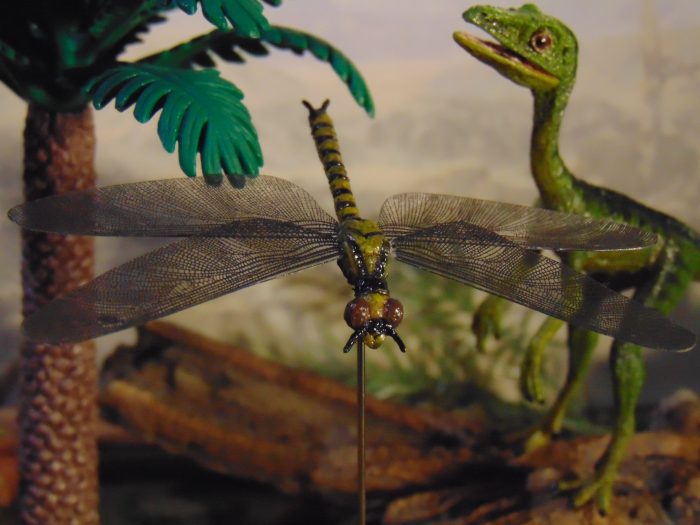
About the Toy: The toy is in 1:6 scale. It is around 6 3/4 in(17 cm) long and 3 in(8 cm) high. The tail is 4 in long. That makes the tail more than half of the total length of the figure. The look of Compspognathus as stated above is a direct homage to the Lost World Jurassic Park. The base color is a glossy yellow green. The back is a darker green, and the underbelly is more yellowish. There is dark striping on the neck, torso, legs, and on the tail. The claws are black, and the entire skin has been subject to a dark wash to bring out the skin texture.
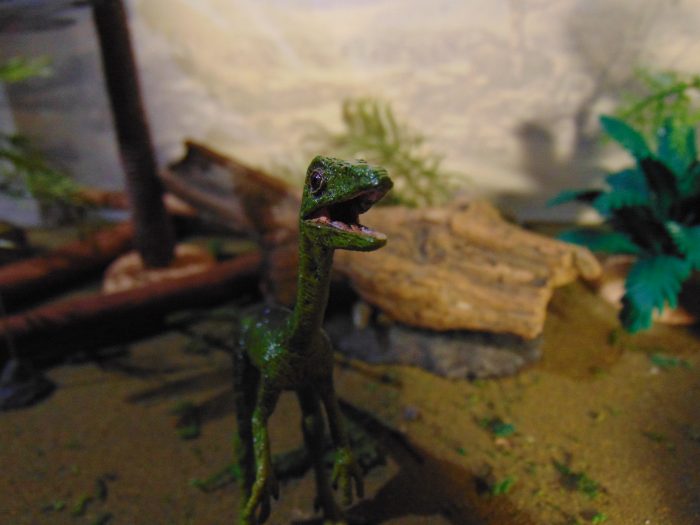
The mouth is articulated. If you open up the mouth it gums and tongue are painted glossy pink. The teeth are very small, and are hard to see from a distance as they blend into the mouth. The eye is also glossy giving it a wet look.
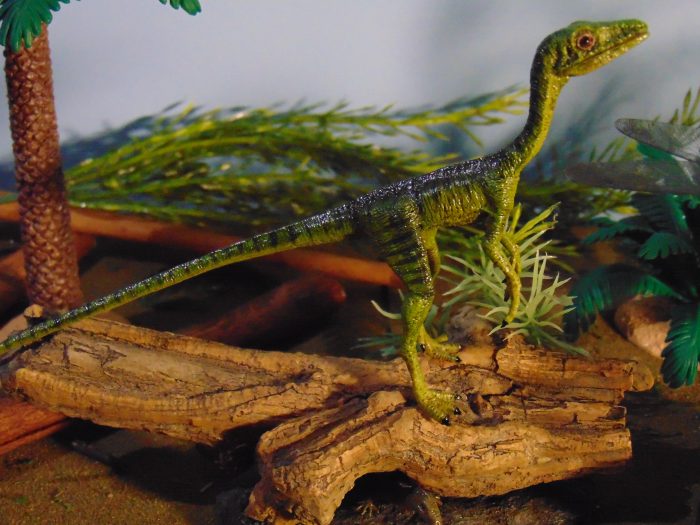
It is in a neutral pose and resting on three points. Due to it being in a tripod, it does not have stability issues. It rests on its really long tail. The legs are directly under the hips and the head is staring straight ahead. There are three fingers on the hand with a reduced 1st digit. The hands are pronated and hanging down. The neck, arms, legs, and tail are all thin and are made of a bendy plastic. The figure looks underfed as it thin and rather lithe.
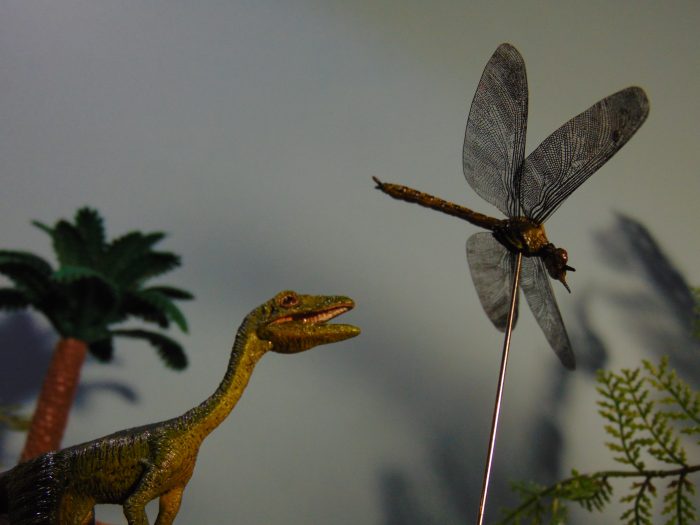
What about the Dragonfly. It has a small swamp rock base with moss on it. A small metal rod fits into the base and into the bottom of the dragonfly. This gives it the appearance of flying. The colorization of the dragonfly is yellow green and black stripes on its thorax and the eyes are red. The dragonfly has two sets of wings — one behind the other. The wings are long with a mosaic of veins running throughout them. It is amazing how real the dragonfly looks, especially from a distance.
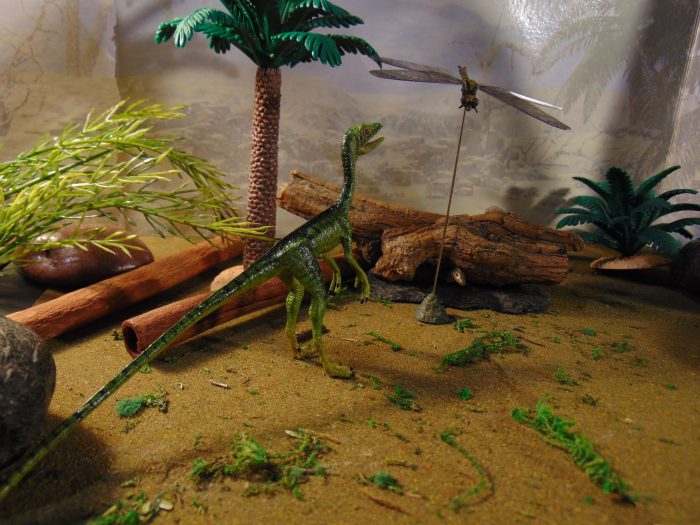
Overall: Scientifically there are some issues with this model other than the pronated hands. If you look at a reconstruction of Compsognsthus, the neck and arms would be a little shorter than they are on this toy. You might wonder why there are no feathers? Since it is meant to mimic the movie the Lost World JP, there are no feathers on it. It is in this capacity were the toy shines. If you compare it to the movie it matches up really well. The lack of feathers might turn some people away from this model, but this toy is not meant to be accurate to science, just accurate to the movie. In that respect Rebor nailed it. This looks like a Stan Winston creation. The food item for the Compsognsthus is the really well done dragonfly. It complements the main figure and is a nice accessory for the shelf or diorama.
Despite the boring pose, I personally find the Jurassic Park Compsognsthus to be rather cute. When I look at it, they way the head is raised on the figure, it looks like a pet that is begging for some food. If you are fan of Stan Winston or Jurassic Park, you might want to give this figure a try. If you only want accuracy, then I would pass on this figure.
Disclaimer: links to Ebay and Amazon on the DinoToyBlog are affiliate links, so we make a small commission if you use them. Thanks for supporting us!




“This might bring up some bile or nostalgic feelings depending on how you feel about the Jurassic Park movies”
A bit of both, to be honest! Even back in 1997 I thought the movie was awful, but the dinosaurs were well done for the time. I’m a bit disapppointed that dino toy producers can’t move on from a 20-year-old film (let alone a 24-year-old one) but it is what it is; and you’re right, it’s got a certain alert character to it.
I find this spindly, skeletal figure rather creepy.
Yes, it is spindly. I think the only reason it doesn’t bother me, is because the ones in the movie were also very skinny and they match up very closely. Maybe I am too soft on JP animals and I give them a pass in this department due to them being movie creations. I agree that a little belly bulge and a little thicker of a tail would help the over all look of the figure.
For all the obvious care that went into the creation of this beastie, it looks a little lean in the gut, the base of the tail looks especially thin, and the pose is downright mammalian. (I suspect the critter would pause in mid stride to consider when to leap upon its unsuspecting prey.) The log and the dragonfly, however, are absolutely surreal!
The log is actually from the Rebor Dimorphodon Punch set.
WOW!!! I want it!!!!
Killekor
I think the Odonata is oversized. When I saw it I ahd to think rather of a Meganeura, which were enormous in size, but lived a bit earlier.
I can confirm that. I have these figures, and whereas the Compsognathus is plausibly 1:5-1:6, the Protolindenia is just barely smaller than life-sized (about 1:1.6).
I have them as well. 😉 Apart from the size also the head doesn’t look very Odonata like
Do you mean because of the big fat antennae, or the protruding mouthparts?
I’d look at a proper description of Meganeura. Now I just looked at some pictures in books. Of course both Meganeura and Odonata have biting mouth parts, but for me the general impression of the head was not really Odonata. I have seen more dragonflies than Meganeura. 🙂
The odonata is disproportionate to the dinosaur if at least it had been meganeura would be more proportioned.